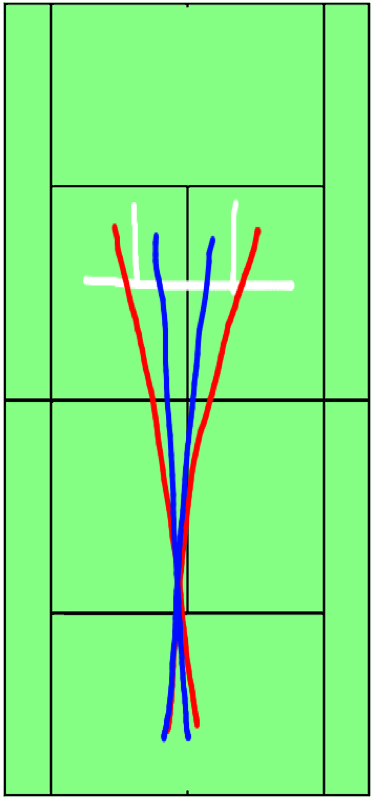Here's a little variation to try when you're doing two-on-ones. Generally, in the 2-on-1 drill, one of the players does all of the hitting and running and it seem like the other players are just barely hitting a shot and then standing around. Sure, the coach can push the players to move their feet but, eventually, the whole concept breaks down when the drill sergeant isn't looking and players are back to standing on their heels.
Instead of trying the same-old, same-old and expecting a different result, place two targets (be them wrist-bands, athletic tape, plastic lines, cones, etc) about 6 feet inside the baseline and 4 feet from each side line. The two players hit down the line (or cross-court) and then SPRINT IN AND TOUCH THE TARGET and pedal back (FIG 2 BELOW). In turn, the single player hits the opposite of the two-player team (i.e., cross-court or down-the line) and aims for the same target (so the target serves as both a point for the player to aim to as well as a spot towards which the two players must run to). The key to this drill is that while the single player moves side-to-side, the two players move forward and back so everybody is getting the benefit of running and hitting although in a different direction.
Conversely (FIG 1 BELOW), have the same set-up as above but put one of the two-player team at the net (the other at the baseline). The two-players hit down the line; the single player hits cross court. However, in this variation, the net player hits the volley and backpedals, touches the cone/target and then sprints IN again to make contact with the volley inside the service line. This is an AWESOME way for the players to practice their first volleys.

Another variation on the 2-on-1 drill is where the two players do most of the moving. The drill is cross-courts (or down-the-line). The two players line up on one half of the court, one behind the other. A cone is placed about 1 foot (or more) in front of the baseline T or slightly into the other half of the court. The single player (or coach) feeds the ball to one of the two guys. This player hits the ball back and then sprints forward and around the cone. The other player then steps in, hits the next shot, sprints in and rounds the cone. If the players are practicing backhands, the two-player team rounds the cone clockwise. If the players are hitting cross-court forehands, the players are rounding the cone counter-clockwise. Many players have done this drill when the ball was fed to them but there's no reason why it can't be done in a live-ball setting. The key is to focus on control and movement. The same concept can be done down the line and the cone can be moved around. It's an awesome way to develop ball control and RECOVERY.
---
The purposes of the 2-on-1 drill is, obviously, to make sure that the single player (i.e., the "one") learns to both move and move the ball around. In tennis, changing the direction of a moving ball (movement #1), while you are in motion (movement #2) with a moving object - the racket (movement #3) is one of the most critical components to understand and master. However, nothing irks me more as a coach than seeing the 2 players loaf around waiting for their turn to get a workout. Although I agree that the primary purpose of the 2-on-1 is to provide the single player with a good workout, the drill often breaks down because the "two" players' minds wander or their feet stop moving.
Above, we have covered things such as hitting the ball and running in and touching the cone. Again the cone can be inside the baseline (serving, also, as a target for the shots of the "one"), at the center T (thereby teaching the "two" to hit and recover) or anywhere else for that matter (e.g. 10 feet behind the baseline or even at the intersection of the baseline and the singles/doubles sideline). The concept, here, is of course, to keep ALL players hitting and moving and to also keep the minds of the "two" players focused on specific tasks in between strokes. In addition to hit-and-recover drills, the players can also include other devices to maintain the intensity of the work-out. For example, there's nothing stopping the "two" players from doing kangaroo jumps (e.g. 2-3), high knee running in place, split-lunges, squat jumps, etc. in between strokes.
 Monday, October 31, 2011 at 05:24PM
Monday, October 31, 2011 at 05:24PM  CAtennis
CAtennis 


